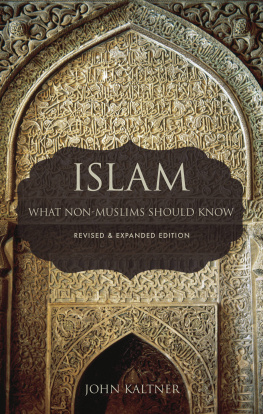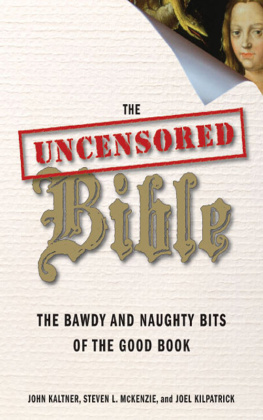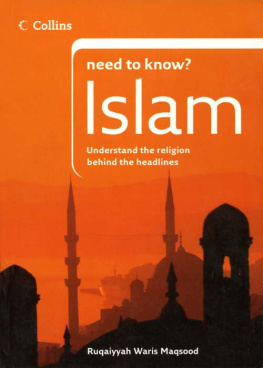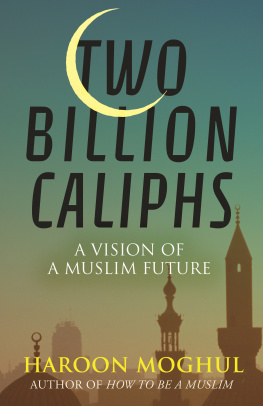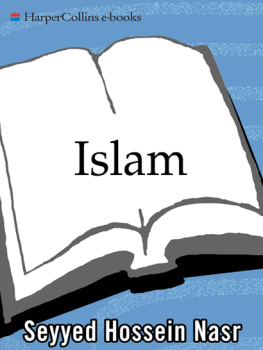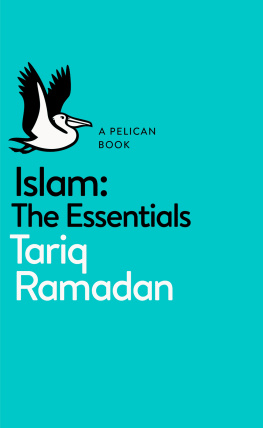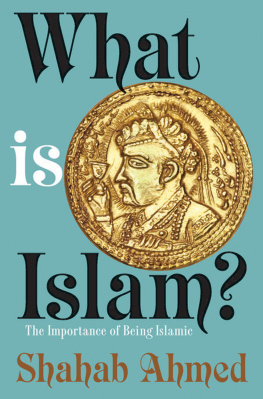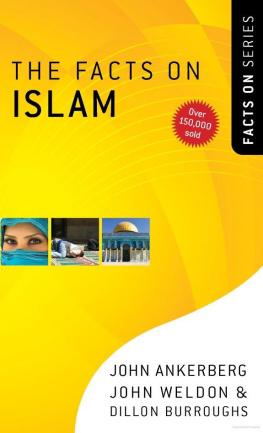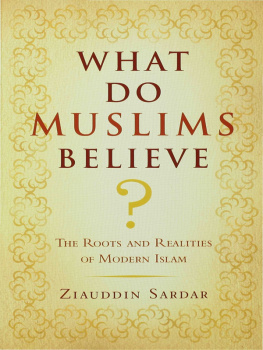Islam
What Non-Muslims Should Know
John Kaltner
Fortress Press
Minneapolis
ISLAM
What Non-Muslims Should Know
Copyright 2016 Fortress Press. All rights reserved. Except for brief quotations in critical articles or reviews, no part of this book may be reproduced in any manner without prior written permission from the publisher.
Visit http://www.augsburgfortress.org/copyrights/ or write to Permissions, Augsburg Fortress, Box 1209, Minneapolis, MN 55440.
Translations from the Arabic are the authors.
Cover image: Iran. Isfahan. Friday Mosque. The Oljeitu Mihrab. 1310. / Photo Tarker / Bridgeman Images
Cover design: Laurie Ingram
Library of Congress Cataloging-in-Publication Data
Print ISBN: 978-1-5064-1666-3
eBook ISBN: 978-1-5064-1667-0
The paper used in this publication meets the minimum requirements of American National Standard for Information Sciences Permanence of Paper for Printed Library Materials, ANSI Z329.48-1984.
Manufactured in the U.S.A.
This book was produced using Pressbooks.com.
To the members of the Memphis Islamic Center
Theirs is an abode of peace from their Lord.
He is their friend because of what they have done.
Quran 6:127
Contents
Islam has been at the center of many events and developments throughout the world since its emergence more than fourteen hundred years ago. In the past several decades alone, it has exerted tremendous influence in the political, social, economic, and spiritual arenas, to name but a few. As the fastest-growing religion in the world, Islam attracts new followers every day, and there is every reason to assume that it will continue to play a leading role on the world stage. It is therefore very important for non-Muslims to know as much as they can about this significant and often misunderstood faith.
The aim of this book is to introduce non-Muslims to the basics of Islam so that they will be encouraged to expand and develop their knowledge of it. The space limitations of this work make a comprehensive introduction to the religion impossible. The six aspects of Islam that are discussed here are central to the faith, and familiarity with them will form a solid foundation upon which to build a more complete understanding of the religion. The list of recommended resources at the end suggests some books and other aids that will facilitate further study of Islam.
The first edition of this book was written in the shadow of the tragic events that occurred on September 11, 2001, when I was invited to speak to many congregations and organizations whose members sought to understand the possible motivations and causes behind the attacks that took place that day. In the intervening years, many non-Muslims have become better informed about Islam, and that might be the one silver lining that can be found within the enormous cloud that was 9/11. Despite this increased awareness on the part of some, though, there are regular reminders that others remain in the dark about the essentials of the religion or rely on misinformation that perpetuates stereotypes and impedes good relations with Muslims. Only a few of these people grab headlines and become the subjects of discussion and debate, like preachers who wish to burn the Quran and politicians who want to ban all Muslims from entering their country. Others are out of the spotlight and remain anonymous, but their distorted impressions of Muslims and Islam can leave their mark nonetheless, and so the work of educating ourselves remains a high priority.
The group to whom this book is dedicated deserves special mention. The Memphis Islamic Center has been tireless and creative in its efforts to improve relations among people of different religious traditions. Its members have hosted and supported many gatherings that have put Muslims and non-Muslims in conversation with one another in ways that have enhanced mutual understanding and respect. I am proud to call them my friends.
The Quran translations used throughout this book are my own. An abbreviated version of this material first appeared in the Winter 2002 issue of Rhodes Magazine. I thank former editor Martha Shepard and the staff of the magazine for their fine work on that article. I also wish to express my gratitude to Fortress Press, particularly Michael West for supporting the first edition of this book, and Will Bergkamp for his assistance with this revised edition. A final word of thanks goes to Debra Bartelli for the encouragement and advice she offered while I wrote and revised this book.
1
Islam Is a Diverse and Complex Faith
Difference of opinion within my community is a sign of the bounty of Allah.
The Prophet Muhammad
No religion in recent times has labored under more stereotypes than Islam. Ask a non-Muslim for a description of the typical Muslim, and he or she will probably respond with one or more stock characterizations, the most common being a veiled woman, a bearded cleric, a desert dweller, and a suicide bomber. If you were to inquire further and ask for practices with which Islam is associated, the list would undoubtedly include such things as polygamy, amputation of limbs, terrorist activities, and anti-Western demonstrations.
What impact do such images and impressions have on non-Muslims? What influence do they exert on attitudes toward Muslims and their faith? The answer to these questions depends on how familiar one is with Islam and its followers. Those who have some understanding of the religion will be able to recognize each of the above responses for what it is: just one manifestation or aspect of Islam. Others, especially those with a less firm grasp of the facts, run a certain risk. They need to avoid the temptation to generalize and therefore see the veiled woman or the suicide bomber as representing the face of Islam, and terrorism as something all Muslims support.
The first thing non-Muslims should know about Islam is that it is a diverse and complex faith. It can be difficult to recognize this fact because we are often presented with a monochromatic and one-dimensional view of the faith. Most of us rely on the news media to get our information about Islam, but the time and space limitations of news coverage rarely allow for the type of in-depth treatment needed to adequately contextualize a story that is related to this complex faith. A further problem is the issue of media bias. Objective reporting about Islam often falls victim to political and personal agendas that can distort the facts and obscure the truth.
Another factor that should not be underestimated is the role that Hollywood and the entertainment industry sometimes plays in shaping impressions of Islam and its adherents. Television and film portrayals often tap into and perpetuate certain stereotypes about Muslims by making them come alive. The experience of seeing ones archetype Muslim on the screen in living color can often be an affirmation of its authenticity, even if it is based on a clich or a misperception.
The simple facts argue against the construction of such a shallow view of Islam. There are currently more than one and one-half billion Muslims in the worldnearly one-quarter of the population of the planetand they are found in every part of the globe. It would be foolish to believe that all of these people think and behave exactly the same way. While all Muslims share certain beliefs and practices, there is a rich diversity to the faith. Many of these differences are inconsequential, but others have profound implications. This chapter will explore the issue of the diversity of the Islamic community.

